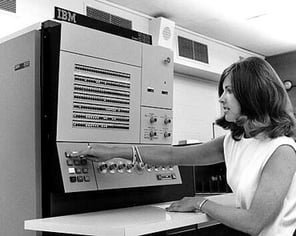Updated: January 8, 2024
The Future is Here: Cloud Solutions You Need to Integrate
In a fast-changing world, businesses need to jump on the right changes and leverage tools that support long-term success. You don't gain the competitive edge by sitting back on your haunches. But what's the difference between a fad and a revolutionary industry change?

While certain trends or technologies only stick around for a short time, others drastically change the trajectory of business operations and consumer preferences, permanently reshaping industry standards.
Cloud solutions are completely revolutionizing how businesses operate. Let's dive into how we got here.
The Evolution of Computing
The computing industry has been on a wild ride over the past 50 years. No one in the 1970s could fully guess what innovative tech the future would offer in 2023. Yet, there have always been dreamers willing to push the boundaries of what is realistic or possible.Star Trek was a great vehicle for computing imagination, with sci-fi inventions that were nearly prophetic:
- The Tricorder was eerily similar to the flip phone design produced in the late '90s.
- Lt. Uhura wore what looked like a Bluetooth earbud 40 years before we had the tech.
- Capt. Jean-Luc Picard's crew used tablet computers 23 years ahead of Apple's creation.
Memory capacities have increased while shrinking in size. When the PC first emerged, the application software and all its files needed to reside on the same 8-inch floppy disk with a storage capacity of 80KB. The average smartphone today holds nearly a million times more, with most offering 64GB on the low end.
How Big Businesses Have Adapted
 Enterprise computing also has had an interesting journey. Some still recall the first mainframe computers that took up entire rooms — or even entire floors — in office buildings.
Enterprise computing also has had an interesting journey. Some still recall the first mainframe computers that took up entire rooms — or even entire floors — in office buildings.
IBM & DEC were major players in the '60s and '70s. Users had a local terminal connected remotely to the mainframe, and all computations and data were housed somewhere else. Maybe, that was just too far away? Clunky systems didn't last long, with innovative minds challenging the status quo at every turn.
Image featuring IBM's Model 22, introduced in 1971.
The rise of the personal computer brought everything close to home. On-premises computing and network services created a nice cozy ecosystem. People moved from strictly static desktops to portable laptops that left the desk when they did (and still connected to the network).
Software providers saw an opportunity to leverage the increasing bandwidth of the internet. They offered user-based "software as a service" (SaaS) that increased user productivity and reduced management requirements. Housing data offsite in the "cloud" was part of that service, and it's completely changed business capacity.
The Rise of Cloud-Based Solutions
The cloud has become top-of-mind in many progressive organizations. Many are using some form of cloud-based services. Some are still holding out and weighing their options. But few are fully utilizing cloud capabilities.
Cloud-based services offer many benefits to users and network administrators. This change marks far more than the next shiny new toy or techie fad in IT.
There are many factors causing a rising interest in cloud-based SaaS solutions. Here are three:
- As organizations manage extensive networks with minimal staff, automation and remote management are paramount.
- As the hacker community gets more sophisticated with their attacks and succeeds in navigating past the firewall, tighter security and off-premises backups are needed.
- As customers demand faster responses and better support, equipment is changing to offer more features and streamlined workflows.
Working With a Cutting-Edge Partner
UBEO can see the importance of cloud services. This is the tech of the future, and industry leaders are jumping on board. If you sit back now, you'll be playing catch-up later.
We'll show you how to:
- Decrease workloads
- Avoid ransomware attacks
- Establish contingency plan
…and more.
As a trusted advisor in the imaging and document management space, UBEO understands how to design, implement, and integrate cloud services into departmental and IT workflows.
Every company has its own network topography, business challenges, and information management scheme in place. UBEO assesses your existing setup before providing a customized plan on how to navigate to the best solution suite to meet your unique business needs.
Are you ready to step into the future? Reach out to our team, and let's get started.
John Propersi
John has been providing sales and support in the office automation industry for over 30 years.



